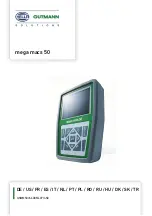
̶ 15 ̶
8. Earth resistance measurement
This instrument can measure the earth resistances of distribution
line, internal wiring and electrical appliance.
#
DANGER
● Never apply inputs exceeding 300V between the measuring
terminals at earth voltage measurements.
● No voltage should be applied between the measuring terminals
during earth resistance measurements.
8-1 Principle of measurement
This instrument carries out earth resistance measurements based
on the fall-of-potential method. This is a simplified earth resistance
tester and uses the existing earth systems (with a sufficiently
low earth resistance) such as buried metal pipes like main water
pipe, common earth for commercial power supply and a lightning
electrode on buildings and performs measurements based on the
2-pole measurement method.
The AC constant current
“
I
” is applied between the
measurement object “
Rx
”
(earth electrode) and the
existing electrode “
re
” to
obtain the earth resistance
value “
Rx
+
re
” and find out
the voltage “
V
” between the
E and H+S(C+P) terminals.
See Fig. 8-1.
Rx + re = V / I
The resistance “
re
” of the existing earth electrode with which
H+S(C+P) terminal is connected is added to the true resistance
“
Rx
” of the measured object, and displayed as the measured result.
Re (measured value) = Rx + re
If the value of “
re
” is already known, deduct it from the measured
value “
Re
” to determine “
Rx
” value.
Rx (true resistance value) = Re – re
H+S (C+P)
terminal
E
terminal
Voltmeter
Earthing system
under test
Earth electrode
Constant current
generator
Secondary
Primary
I→
Fig. 8-1
Summary of Contents for kew 4300
Page 1: ...Instruction Manual Simplified Earth Tester KEW 4300...
Page 22: ...20 MEMO...
Page 23: ...21 MEMO...








































